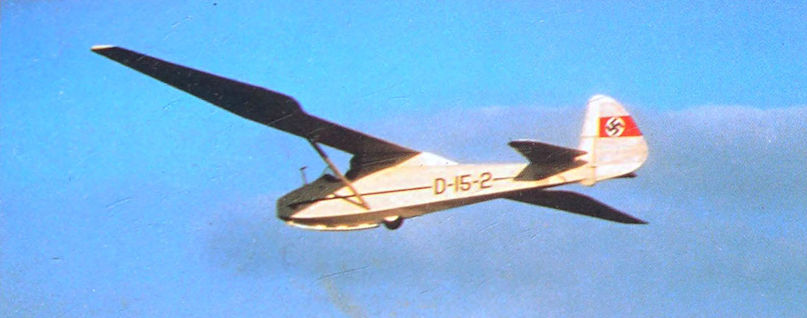
Варианты
- Schneider - Grunau Baby - 1931 - Германия
- Dart - Cambridge - 1935 - Великобритания
- Goppingen - Go.1 Wolf - 1935 - Германия
- Slingsby - T.6/T.23 Kirby Kite - 1935 - Великобритания
- Slingsby - T.7 Kirby Cadet / T.8 Kirby Tutor / T.20 / T.31 - 1936 - Великобритания
- Slingsby - T.12 / T.14 / T.15 Gull - 1938 - Великобритания
- Slingsby - T.21 Sedbergh / T.30 Prefect - 1944 - Великобритания
- Slingsby - T.29 Motor-Tutor - 1947 - Великобритания
M.Simons The World's Vintage Sailplanes 1908-45
THE WOLF
The first type produced by the new firm, Sportflugzeugbau Goeppingen, or Schempp-Hirth, formed in 1935 by Martin Schempp and Wolf Hirth, was the Goeppingen 1, Wolf. The chief draughtsman responsible for most of the work was Reinhold Seeger. The idea was to produce a strong training sailplane in the Grunau Baby class. The wing was aerodynamically similar to the Baby, but had lobate ailerons of very broad chord and with differential gearing. The wing was strut-braced and mounted on a high, narrow pylon. The upper fuselage decking was curved but the sides and belly were straight in cross-section. The open cockpit was provided with a detachable canopy and windscreen, a landing wheel was built in, and a skid protected the nose of the aircraft.
The first Wolf off the production line was sold to Alan Cobham’s Air Circus and was towed to England with Joan Meakin as pilot and Hirth himself as tug pilot. Miss Meakin toured England with the circus, putting on aerobatic shows. The Wolf was fitted with a two-way radio to assist in timing her displays, one of the first occasions a sailplane was equipped in this way. The fourth Wolf was also exported, to the USA, and four more went to Japan when Wolf Hirth visited that country to demonstrate gliding and soaring. Yet another was built, from plans, in the USA. For 1936, an improved version was produced. This had ailerons of different planform, the chord reduced and the area distributed more toward the tip, helping to prevent dangerous tip-stalling and spinning. It was noted that the Wolf tended to enter spins more readily than the Grunau Baby and a pilot converting from the Baby to the Wolf needed careful advice at this point.
For aerobatics, including inverted flight, the Wolf could be fitted with an extra wing strut, designed to support the rear spar in the inverted position only, a rubber pad being inserted between the strut end and the spar so that load was taken only when the rubber was in compression.
In November 1938, all Wolfs were grounded, a decision prompted by a number of spinning accidents. The wing-dropping tendency was cured in 1940 by retrospective modification of the ailerons. The normal sealed hinge was causing flow breakway and excess drag at the wingtips, so a slotted aileron was designed, proving completely successful. These changes came too late for most of the aircraft which, by this time, had been allowed to fall out of use. Three of the type survived in 1980, one in the USA, one in Brazil and the third in South Africa.
Technical data:
Wolf, 1935: Span, 14.00 m. Wing area. 15 sq m. Aspect ratio. 13. Empty weight, 145 kg. Flying weight, 220 kg. Wing loading 14.66 kg/sq m. Aerofoils. Goettingen 535 at root, tapering to a thin symmetrical section at the tip.
Wolf 1936: As for 1935 version but 5 kg heavier. Wing loading. 15 kg/sq m.
- M.Simons The World's Vintage Sailplanes 1908-45
Фотографии
-
GL / M.Simons - The World's Vintage Sailplanes 1908-45 /Kookaburra/
Регистрационный номер: D-15-2 The Wolf flying in the USA. This example, one of only two or three remaining, has the wingtips modified to prevent tip stalling, and the nose of the fuselage has also been altered. The color scheme is an accurate reproduction of a typical pre-1940 German style, but the registration numbers are not authentic.
-
GL / M.Simons - The World's Vintage Sailplanes 1908-45 /Kookaburra/
A Wolf with the later form of aileron, shown with blue and pale cream sunrays for acrobatic displays.
-
Flight 1935-04 / Flight
Miss Meakin wheels her special glider into position for the tow-off Sir Alan himself brings up the end of the cable.
-
Aeroplane Monthly 1986-08 / F.Bullmore - Circus Pilot (4)
Joan Meakin preparing for a flight in her Wolf glider.
-
Flight 1935-04 / Flight
Flt Lt Geoffrey Tyson surveys a sea of upturned faces from his inverted Lynx-engined Avro Tutor G-ABZP at Redhill on April 13, 1935.
Другие самолёты на фотографии: Avro Tutor/Sea Tutor/Prefect / Type 621/646/626 - Великобритания - 1929
-
Flight 1936-04 / Flight
The Fleet: Miss Joan Meakin's Wolf glider, the Airspeed Ferry, and the B.A.C. Drone are in the foreground.
Другие самолёты на фотографии: Airspeed Ferry / AS.4 - Великобритания - 1932Kronfeld Drone - Великобритания - 1932
-
GL / M.Simons - The World's Vintage Sailplanes 1908-45 /Kookaburra/
Регистрационный номер: J-BGOH An early Wolf with broad ailerons, after arrival in Japan in 1935. The colors were probably pale cream and blue and the words Segelflugzeugbau Goppingen appeared on the rudder below the J, with DAIMAI above. Under the tailplane was the legend in English, Designed by Wolf Hirth.
- Фотографии







